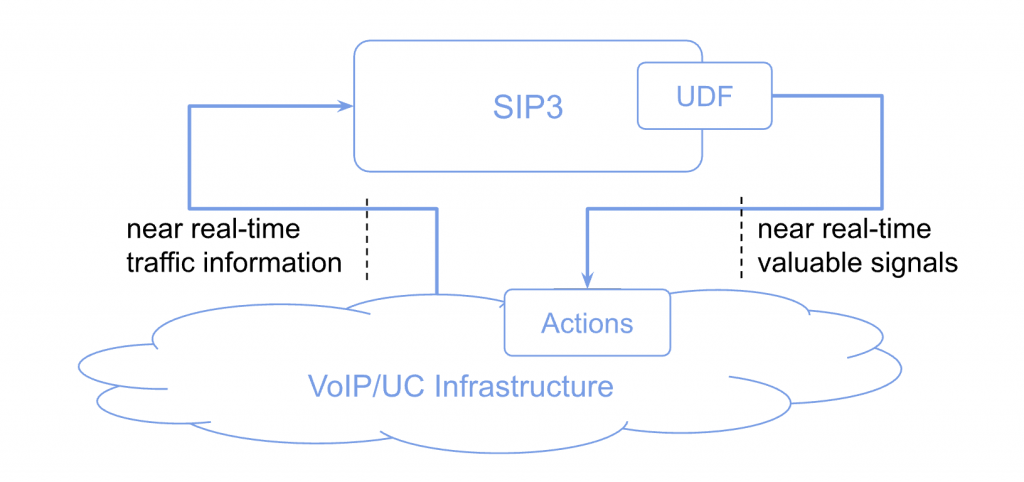You have probably seen previously published materials on how SIP3 supports customer service improvement and enhances observability and operations for engineering teams. In this piece, we’d like to share automation scenarios enabled by SIP3 for VoIP service delivery infrastructure.
SIP3 is a software solution designed to address a wide range of infrastructure challenges in delivering Real-Time Communication (RTC) services, such as Voice and Video over IP (VoIP) and Unified Communications (UC). It is particularly valuable for companies specializing in service delivery – VoIP/UC service providers, including VoLTE/IMS operators, SIP trunking providers, wholesale traffic carriers, contact center platforms, Platform-as-a-Service (PaaS) vendors, and developers of software or integrated software-hardware solutions for the communications industry.
Everything found in today’s RTC service delivery infrastructure stems from two major technological roots: traditional telecommunications and the Internet industry. VoIP and UC are essentially the result of this convergence. Modern voice and video communication technologies in 4G, 5G, and emerging 6G networks are fundamentally based on the same principles and protocols as VoIP and UC, albeit with network-specific adaptations. Core telephone exchange interconnects also rely on VoIP. Likewise, corporate and contact center connectivity to telecom networks for voice processing has long been powered by VoIP in the form of SIP trunking.
Cloud service providers offering features like virtual phone numbers, voicemail, and conferencing—as well as Over-the-Top (OTT) communication providers—also heavily rely on the same core technologies as traditional players in the telecommunications industry.
One of the key outcomes of this technological convergence has been the adoption of infrastructure principles that avoid single points of failure when delivering business-critical services. Additionally, the industry leverages dynamic scaling and resource optimization—allocating and releasing compute and networking capacity in response to demand fluctuations. This is a direct and transparent benefit of virtualization, containerization, and cloud-native technologies.
In an environment where every voice or video call, every message or file transfer (even faxes, which today also travel via VoIP) follows a unique technical path – one that may no longer exist in the same form just minutes later – life becomes unbearable for teams supporting service delivery infrastructure without SIP3 technology.
SIP3 technology is built on the collection of raw traffic processing data, which can be further enriched with logs and additional sources. A well-configured SIP3 installation provides comprehensive visibility into the operation of every node involved in service delivery, every communication channel used, each individual call, and all key performance and service health indicators.
Among the key metrics SIP3 collects for you are:
- Number of call setup attempts
- Call setup success rate
- Call durations
- Call setup and teardown latency
- Infrastructure node response times
- Voice/video transmission quality
The full list of built-in metrics is available on the SIP3 documentation website.
In most cases, these metrics can be gathered both at the infrastructure-wide level and for each individual service node or traffic direction.
The real-time values and time series of SIP3 service delivery metrics enable automation scenarios based both on threshold breaches and on evolving trends identified through machine learning techniques.
For example, SIP3 can help automatically scale up resources in response to increasing traffic—maximizing revenue opportunities—or scale down idle nodes to avoid underutilization and unnecessary costs.
Another example is a drop in average call duration. Everything in your infrastructure appears to be functioning normally – no alerts, no visible faults – yet the average call length is decreasing. This may indicate that users are unable to communicate effectively, leading to lost revenue or reduced customer loyalty. Analysing such situations are particularly valuable for powering automated routing decisions and optimizing Least Cost Routing (LCR) strategies.
SIP3 also unlocks new business scenarios – such as billing only for high-quality calls to increase customer loyalty. With SIP3, your infrastructure gains precise quality metrics for each delivered call, which can be used as the basis for dynamic pricing models. This enables the creation of billing systems similar to blockchain-style smart contracts, where charges are tied directly to service quality.
The overall interaction flow for implementing automation scenarios is illustrated in the diagram below.

About the Diagram: The primary data source for automation is real-time traffic information. SIP3 agents (SIP3 Captains) capture, pre-process, and forward this data with minimal delay to the SIP3 core engine—Salto. At the Salto level, you can configure custom logic using User Defined Functions (UDFs), which can trigger timely control actions across your infrastructure.
One of SIP3’s clients – a provider of large-scale UC communication services – successfully implemented password brute-force protection and secured their network from malicious actors using SIP3.
SIP3 continuously collected and analyzed traffic data to support both customer service optimization and engineering operations. By monitoring SIP REGISTER activity from client endpoints, engineers identified a pattern of repeated failed login attempts from specific IP addresses – clear signs of a brute-force attack.The intruders were attempting to guess SIP credentials to hijack user accounts and place unauthorized calls at someone else’s expense.
Within a single day, the engineering team developed, tested, and deployed a custom User Defined Function (UDF) within SIP3. This function automatically added the offending IP addresses to a greylist – enforcing temporary bans via network access-lists. Crucially, this solution required no changes to the more complex logic of the telephony or messaging platforms.
As a result, the client reduced infrastructure load by 30%, protected customer funds, and reinforced trust in their service.
Automation scenarios with SIP3 can range from simple rules to highly sophisticated logic – including integration with neural networks (AI truly offers incredible capabilities today!).
The SIP3 team is always ready to provide expert consultation and training for system integrators, solution vendors, and service providers alike. Engineering teams – whether from partner organizations or internal client departments – can combine SIP3 UDFs with their own Terraform or Ansible scripts to dynamically scale traffic processing nodes up or down. After all, no one wants to pay for idle cloud resources, but service disruptions due to resource shortages are equally unacceptable. SIP3 helps strike the right balance.
Stay connected with us – read, respond, and share our materials if you find them useful. Reach out through any convenient channel – we’re here to help make your operations smarter and more automated.
Explore our blog: https://sip3.io
